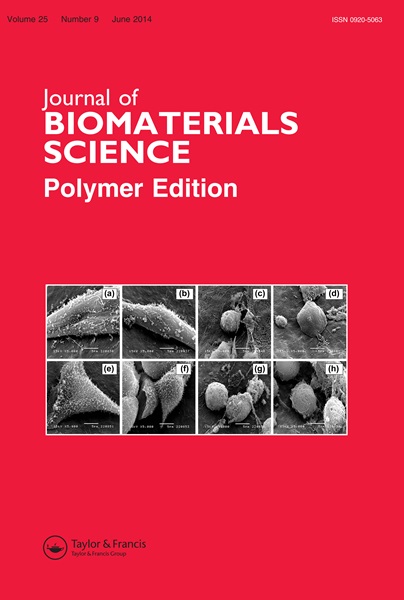Dual-layer nanofibrous PCL/gelatin membrane as a sealant barrier to prevent postoperative pancreatic leakage.
IF 3.6
4区 医学
Q2 ENGINEERING, BIOMEDICAL
Journal of Biomaterials Science, Polymer Edition
Pub Date : 2024-09-18
DOI:10.1080/09205063.2024.2402135
引用次数: 0
Abstract
Post-operative pancreatic leakage is a severe surgical complication that can cause internal bleeding, infections, multiple organ damage, and even death. To prevent pancreatic leakage and enhance the protection of the suture lining and tissue regeneration, a dual-layer nanofibrous membrane composed of synthetic polymer polycaprolactone (PCL) and biopolymer gelatin was developed. The fabrication of this dual-layer (PGI-PGO) membrane was achieved through the electrospinning technique, with the inner layer (PGI) containing 2% PCL (w/v) and 10% gelatin (w/v), and the outer layer (PGO) containing 10% PCL (w/v) and 10% gelatin (w/v) in mixing ratios of 2:1 and 1:1, respectively. Experimental results indicated that a higher gelatin content reduced fiber diameter enhanced the hydrophilicity of the PGI layer compared to the PGO layer, improved the membrane's biodegradability, and increased its adhesive properties. In vitro biocompatibility assessments with L929 fibroblast cells showed enhanced cell proliferation in the PGI-PGO membrane. In vivo studies confirmed that the PGI-PGO membrane effectively protected the suture line without any instances of leakage and promoted wound healing within four weeks post-surgery. In conclusion, the nanofibrous PGI-PGO membrane demonstrates a promising therapeutic potential to prevent postoperative pancreatic leakage.双层纳米纤维 PCL/明胶膜作为密封屏障,防止术后胰腺渗漏。
术后胰腺渗漏是一种严重的外科并发症,可导致内出血、感染、多器官损伤甚至死亡。为了防止胰腺渗漏,加强对缝线内衬的保护和组织再生,研究人员开发了一种由合成聚合物聚己内酯(PCL)和生物聚合物明胶组成的双层纳米纤维膜。这种双层膜(PGI-PGO)是通过电纺丝技术制成的,内层(PGI)含有 2% PCL(重量比)和 10% 明胶(重量比),外层(PGO)含有 10% PCL(重量比)和 10% 明胶(重量比),混合比例分别为 2:1 和 1:1。实验结果表明,与 PGO 层相比,明胶含量越高,纤维直径越小,PGI 层的亲水性就越强,膜的生物降解性就越好,粘合性也越强。用 L929 成纤维细胞进行的体外生物相容性评估显示,PGI-PGO 膜的细胞增殖能力更强。体内研究证实,PGI-PGO 膜能有效保护缝合线,不会出现任何渗漏,并能在术后四周内促进伤口愈合。总之,纳米纤维 PGI-PGO 膜在防止胰腺术后渗漏方面具有良好的治疗潜力。
本文章由计算机程序翻译,如有差异,请以英文原文为准。
求助全文
约1分钟内获得全文
求助全文
来源期刊

Journal of Biomaterials Science, Polymer Edition
工程技术-材料科学:生物材料
CiteScore
7.10
自引率
5.60%
发文量
117
审稿时长
1.5 months
期刊介绍:
The Journal of Biomaterials Science, Polymer Edition publishes fundamental research on the properties of polymeric biomaterials and the mechanisms of interaction between such biomaterials and living organisms, with special emphasis on the molecular and cellular levels.
The scope of the journal includes polymers for drug delivery, tissue engineering, large molecules in living organisms like DNA, proteins and more. As such, the Journal of Biomaterials Science, Polymer Edition combines biomaterials applications in biomedical, pharmaceutical and biological fields.
 求助内容:
求助内容: 应助结果提醒方式:
应助结果提醒方式:


